Critical speed in the rat: implications for hindlimb muscle blood flow distribution and fibre recruitment
- PMID: 20962004
- PMCID: PMC3036198
- DOI: 10.1113/jphysiol.2010.198382
Critical speed in the rat: implications for hindlimb muscle blood flow distribution and fibre recruitment
Abstract
Critical speed (CS) constitutes an important metabolic and performance demarcator. However, active skeletal muscle blood flow distribution specifically surrounding CS remains unknown. We tested the hypotheses that CS could be accurately determined in the running rat and that measurement of hindlimb inter- and intramuscular blood flow below and above CS would support that the greatest muscle fibre recruitment above, relative to below, CS occurs in the predominantly glycolytic muscles. Seven male Sprague-Dawley rats performed five constant-speed tests to exhaustion at speeds between 95 and 115% of the speed that elicited to determine CS. Subsequent constant-speed tests were performed at speeds incrementally surrounding CS to determine time to exhaustion, V(O2), and hindlimb muscle blood flow distribution. Speed and time to exhaustion conformed to a hyperbolic relationship (r(2) = 0.92 ± 0.03) which corresponded to a linear 1/time function (r(2) = 0.93 ± 0.02) with a CS of 48.6 ± 1.0 m min(-1). Time to exhaustion below CS was ∼ 5× greater (P < 0.01) than that above. Below CS V(O2) stabilized at a submaximal value (58.5 ± 2.5 ml kg(-1) min(-1)) whereas above CS (81.7 ± 2.5 ml kg(-1) min(-1)) increased to (84.0 ± 1.8 ml kg(-1) min(-1), P > 0.05 vs. above CS). The 11 individual muscles or muscle parts that evidenced the greatest blood flow increases above, relative to below, CS were composed of ≥ 69% Type IIb/d/x muscle fibres. Moreover, there was a significant correlation (P < 0.05, r = 0.42) between the increased blood flow above expressed relative to below CS and the percentage Type IIb/d/x fibres found in the individual muscles or muscle parts. These data validate the powerful CS construct in the rat and identify that running above CS, relative to below CS, incurs disproportionate blood flow increases (indicative of recruitment) in predominantly highly glycolytic muscle fibres.
Figures
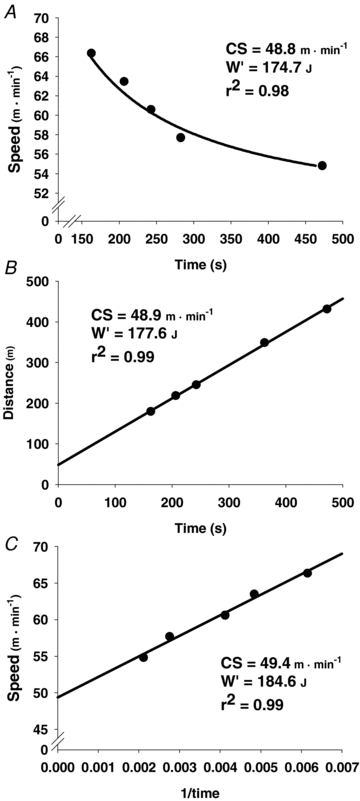
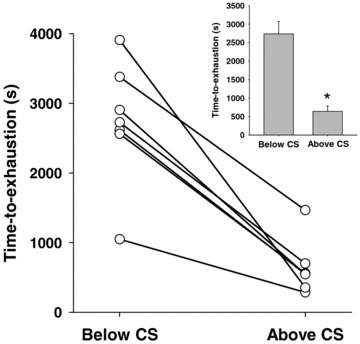
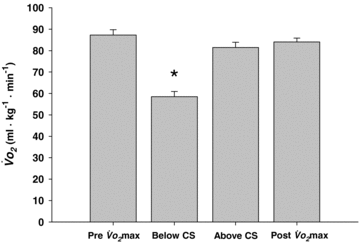

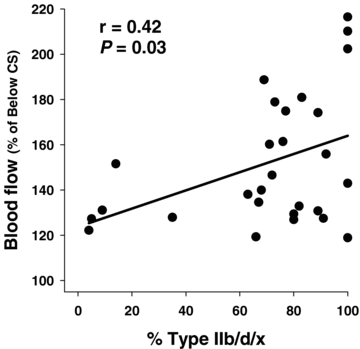
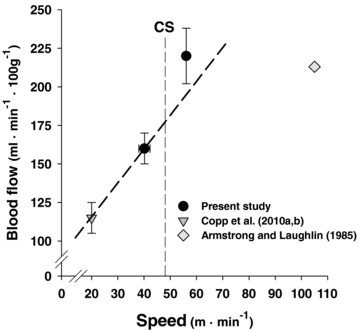
Comment in
-
Comfortable at just below your critical speed: how is blood flow distribution coupled to muscle fibre recruitment during exercise?J Physiol. 2011 May 1;589(Pt 9):2113-4. doi: 10.1113/jphysiol.2011.206342. J Physiol. 2011. PMID: 21532031 Free PMC article. No abstract available.
Similar articles
-
Muscle fibre-type dependence of neuronal nitric oxide synthase-mediated vascular control in the rat during high speed treadmill running.J Physiol. 2013 Jun 1;591(11):2885-96. doi: 10.1113/jphysiol.2013.251082. Epub 2013 Mar 18. J Physiol. 2013. PMID: 23507879 Free PMC article.
-
Impact of dietary nitrate supplementation via beetroot juice on exercising muscle vascular control in rats.J Physiol. 2013 Jan 15;591(2):547-57. doi: 10.1113/jphysiol.2012.243121. Epub 2012 Oct 15. J Physiol. 2013. PMID: 23070702 Free PMC article.
-
Nitric oxide synthase inhibition during treadmill exercise reveals fiber-type specific vascular control in the rat hindlimb.Am J Physiol Regul Integr Comp Physiol. 2010 Feb;298(2):R478-85. doi: 10.1152/ajpregu.00631.2009. Epub 2009 Dec 9. Am J Physiol Regul Integr Comp Physiol. 2010. PMID: 20007515 Free PMC article.
-
Effects of neuronal nitric oxide synthase inhibition on resting and exercising hindlimb muscle blood flow in the rat.J Physiol. 2010 Apr 15;588(Pt 8):1321-31. doi: 10.1113/jphysiol.2009.183723. Epub 2010 Feb 22. J Physiol. 2010. PMID: 20176629 Free PMC article.
-
Central and peripheral factors mechanistically linked to exercise intolerance in heart failure with reduced ejection fraction.Am J Physiol Heart Circ Physiol. 2019 Aug 1;317(2):H434-H444. doi: 10.1152/ajpheart.00164.2019. Epub 2019 Jun 21. Am J Physiol Heart Circ Physiol. 2019. PMID: 31225988 Free PMC article.
Cited by
-
Sexual dimorphism in vascular ATP-sensitive K+ channel function supporting interstitial via convective and/or diffusive O2 transport.J Physiol. 2021 Jul;599(13):3279-3293. doi: 10.1113/JP281120. Epub 2021 Jun 8. J Physiol. 2021. PMID: 34101850 Free PMC article.
-
Influence of blood flow occlusion on the development of peripheral and central fatigue during small muscle mass handgrip exercise.J Physiol. 2015 Sep 1;593(17):4043-54. doi: 10.1113/JP270424. Epub 2015 Aug 2. J Physiol. 2015. PMID: 26104881 Free PMC article.
-
The effect of resting blood flow occlusion on exercise tolerance and W'.Am J Physiol Regul Integr Comp Physiol. 2015 Sep 15;309(6):R684-91. doi: 10.1152/ajpregu.00283.2015. Epub 2015 Jul 29. Am J Physiol Regul Integr Comp Physiol. 2015. PMID: 26224689 Free PMC article.
-
Targeting lung heme iron by aerosol hemopexin adminstration in sickle cell disease pulmonary hypertension.Free Radic Biol Med. 2025 Mar 1;229:458-473. doi: 10.1016/j.freeradbiomed.2025.01.045. Epub 2025 Jan 23. Free Radic Biol Med. 2025. PMID: 39862998
-
The power-duration relationship of high-intensity exercise: from mathematical parameters to physiological mechanisms.J Physiol. 2011 May 15;589(Pt 10):2443-5. doi: 10.1113/jphysiol.2011.209346. J Physiol. 2011. PMID: 21572143 Free PMC article. No abstract available.
References
-
- Armstrong RB, Laughlin MH. Rat muscle blood flows during high-speed locomotion. J Appl Physiol. 1985;59:1322–1328. - PubMed
-
- Billat VL, Mouisel E, Roblot N, Melki J. Inter- and intrastrain variation in mouse critical running speed. J Appl Physiol. 2005;98:1258–1263. - PubMed
-
-
Copp SW, Davis RT, Poole DC, Musch TI. Reproducibility of endurance capacity and
 peak in male Sprague-Dawley rats. J Appl Physiol. 2009;106:1072–1078.
-
PubMed
peak in male Sprague-Dawley rats. J Appl Physiol. 2009;106:1072–1078.
-
PubMed
-
Copp SW, Davis RT, Poole DC, Musch TI. Reproducibility of endurance capacity and
Publication types
MeSH terms
LinkOut - more resources
Full Text Sources
Miscellaneous

